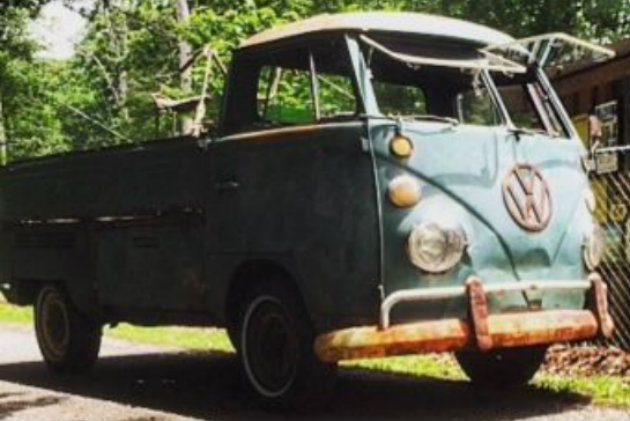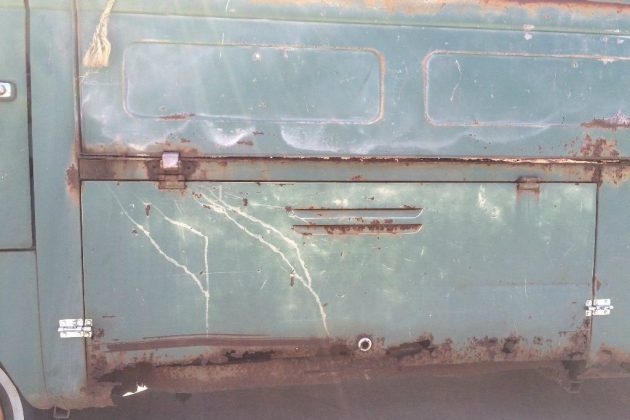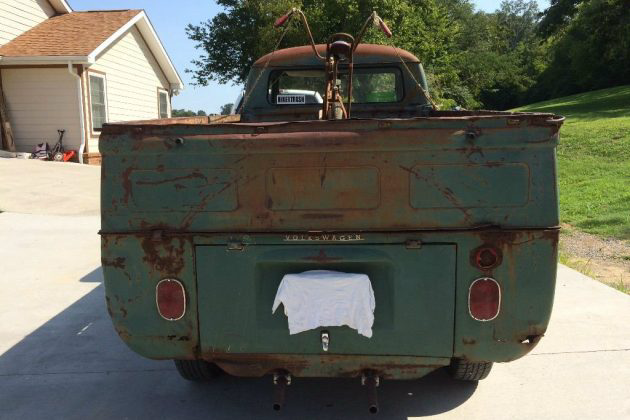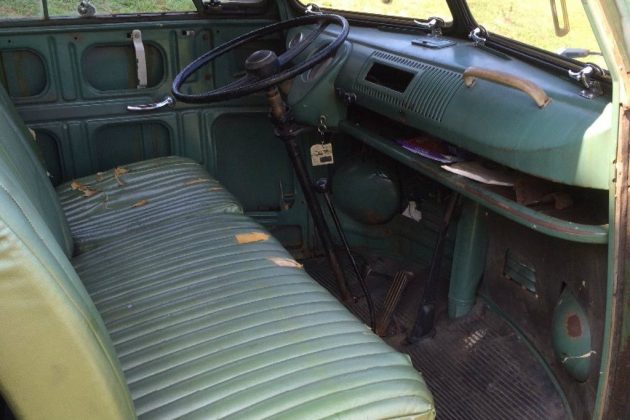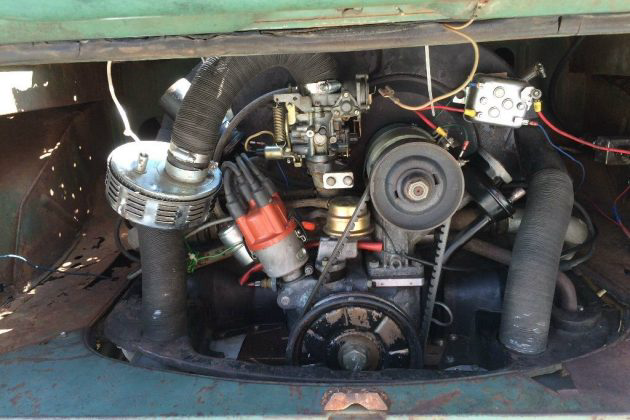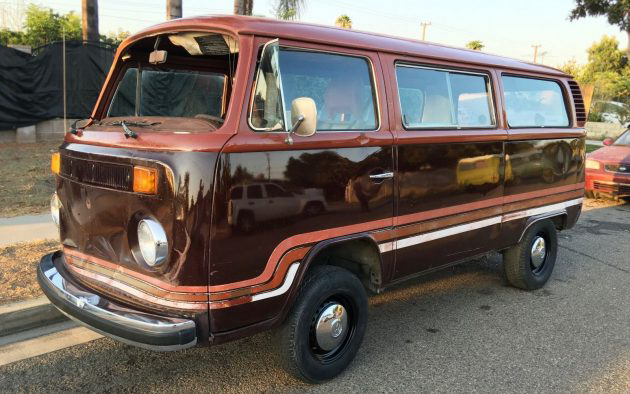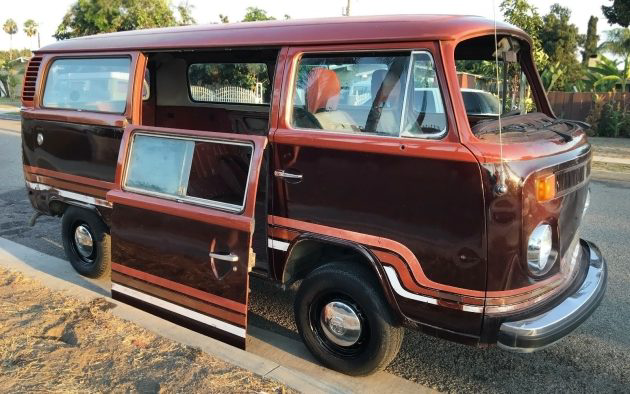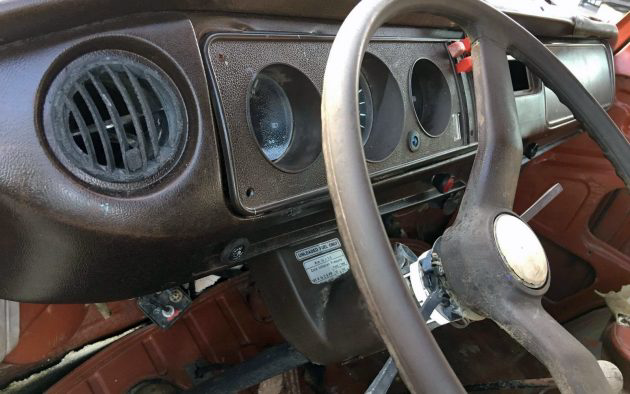Sunday, October 2, 2016
1970 VW Kombi Transporter

We have featured any number of seemingly over-priced and over-rusted old Volkswagen buses over the years. The early ones have seen prices literally go crazy over the past few years. Personally, I don’t get it, and I lived through and enjoyed the original days of the “hippie bus” craze.

At least in my experience, while they were incredibly practical, inexpensive to operate and easy to maintain, they were also dangerously slow in both acceleration and maximum speed, handled terribly, and worst, were prone to acting like giant sails in strong winds.

Since Transporter buses were extremely light, wind could move them across lanes on highways pretty easily. I was a passenger in one of these on the Bay Bridge going from San Francisco to Berkeley. A strong wind took us across two lanes of traffic and we were just incredibly lucky that it was at night, and that there were no cars in the lanes next to us. That was not a thrill, and pretty much cured me of any desire I had to ever own one of these VW Kombis for myself.

And
of course, with almost no structure in front of the front seats, if you
happened to hit anything head on, you were much more likely to be
injured or killed than if driving just about any other vehicle.
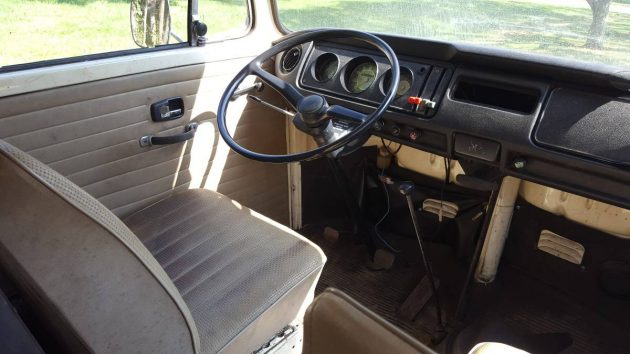
This 1970 Transporter (also called a Kombi station wagon) for sale here on craigslist in Trumbull, Connecticut appears to be in much better condition than many (though not all) of the other similar VW buses that have appeared here over the years. The seller says his bus is “all original, runs, shifts thru gear, no brakes need to go thru….Solid body, floor and rear area. Minimal rust, only surface rust. All jack points and frame solid.”
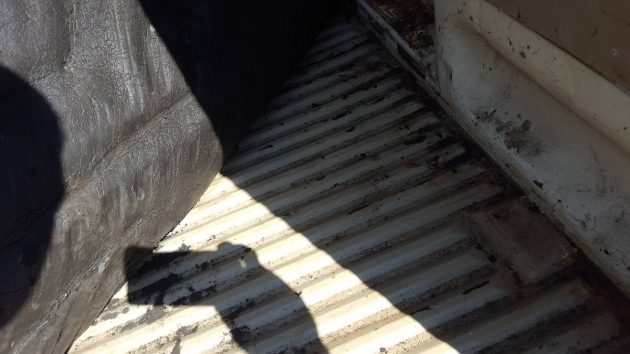
This bus also comes with some extra parts and a modest $4100 asking price. At least from the pictures, it appears to have solid floors, a far better than average interior, and an engine that must have been rebuilt or at least kept very clean over the past several years. Mileage on the bus is said to be a very modest 93,000 miles, which could be true based on the condition of this Vee Dub. The older Connecticut license plate suggests it has been off the road for some time as well.
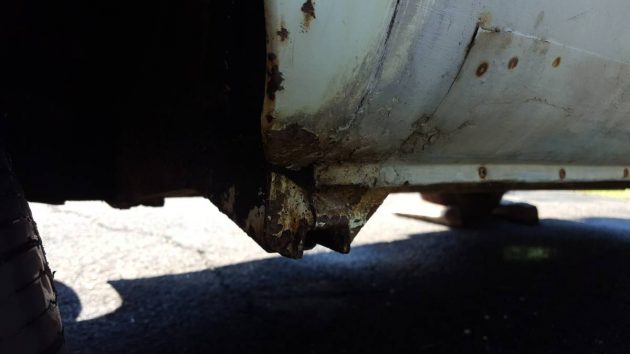
On the other hand, the rust shown here appears, at least to me, to be much more than superficial, and there is pretty clear evidence this bus has had some amateur body work done to it in the past. Given that it’s now more than 45 years old and seems to have been in Connecticut for some time, it’s impossible for it *not* to have rust issues. But for $4,100, this seems like a good deal, especially if the floors and frame do turn out to be solid.
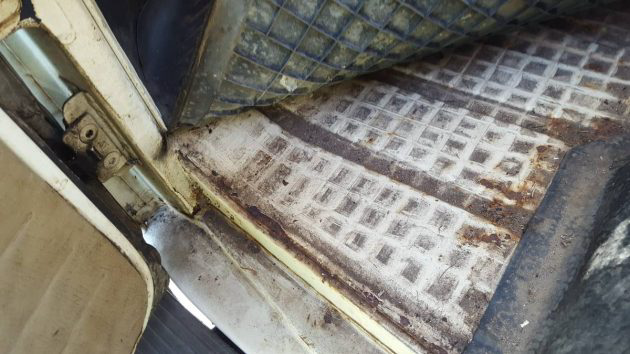 I’ll
be very interested to hear what our readers have to say about this old
bus. NADA says the low retail for one of these is now about $7,400 – so
is this one a good deal or not?
I’ll
be very interested to hear what our readers have to say about this old
bus. NADA says the low retail for one of these is now about $7,400 – so
is this one a good deal or not?
Source: barnfinds.com

This 1970 Transporter (also called a Kombi station wagon) for sale here on craigslist in Trumbull, Connecticut appears to be in much better condition than many (though not all) of the other similar VW buses that have appeared here over the years. The seller says his bus is “all original, runs, shifts thru gear, no brakes need to go thru….Solid body, floor and rear area. Minimal rust, only surface rust. All jack points and frame solid.”

This bus also comes with some extra parts and a modest $4100 asking price. At least from the pictures, it appears to have solid floors, a far better than average interior, and an engine that must have been rebuilt or at least kept very clean over the past several years. Mileage on the bus is said to be a very modest 93,000 miles, which could be true based on the condition of this Vee Dub. The older Connecticut license plate suggests it has been off the road for some time as well.

On the other hand, the rust shown here appears, at least to me, to be much more than superficial, and there is pretty clear evidence this bus has had some amateur body work done to it in the past. Given that it’s now more than 45 years old and seems to have been in Connecticut for some time, it’s impossible for it *not* to have rust issues. But for $4,100, this seems like a good deal, especially if the floors and frame do turn out to be solid.
 I’ll
be very interested to hear what our readers have to say about this old
bus. NADA says the low retail for one of these is now about $7,400 – so
is this one a good deal or not?
I’ll
be very interested to hear what our readers have to say about this old
bus. NADA says the low retail for one of these is now about $7,400 – so
is this one a good deal or not?Source: barnfinds.com
Unrestored 1963 Porsche 356 Super 90
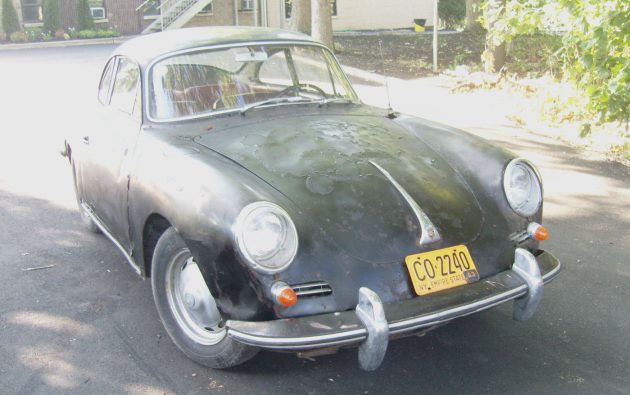
The seller of this Porsche 356 claims that it has never been restored. If you have ever tried to restore a car, then you know that is usually a very good thing. Seemingly shiny restored cars can hide unimaginable horrors. Wadded up newspaper in the Bondo, hacked up wiring, and other blotched repair jobs. That isn’t always the case, but if you want to do the job right, it’s probably best to start with an original car. If this one really is as unmolested as the seller claims, it may be worth pursuing. It’s listed here on eBay and the auction ends tonight.
Source: barnfinds.com
Pickup Conversion: 1967 Volkswagen Squareback

The owner says that 15 VW Type 3s were “costumed” in California in the ’70’s. We don’t know what the heck that mean, but we like it! Have you seen one of these before? Listed here on craigslist Southern California is this 1967 Volkswagen Type 3 that is no longer “square” and priced at $9,900.

The car runs great, it has recently been painted and upholstered.
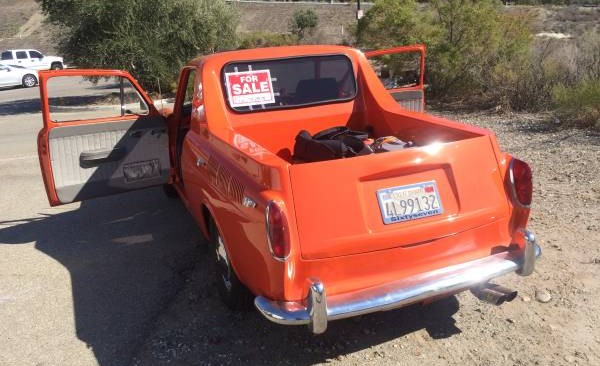
There are new tires, a rebuilt engine and transmission. There are no images of either of these or the underside of the vehicle. If you missed the Volvo pickup we featured earlier this month you may want to pick this one up while you can.
Source: barnfinds.com
Conversion By Roadrunner: 1967 Volkswagen Camper
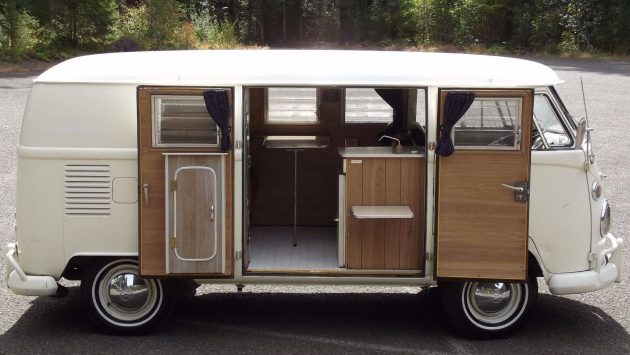
People sure love these old VW buses, especially when they are in camper form! Most people think of Westfalia when they think these, but there were actually quite a few companies that performed the conversions. Roadrunner was one of them and according to some people, it was among the best. Either way, the last few owners really loved this bus. It was parked for about 20 years, but the seller claims to have spent over $5k making it roadworthy again. It seems like a good choice if you are looking for a classic camper that can be used right away. Find it here on eBay where bidding ends tonight.
Source: barnfinds.com
1964 Sunroof Beetle
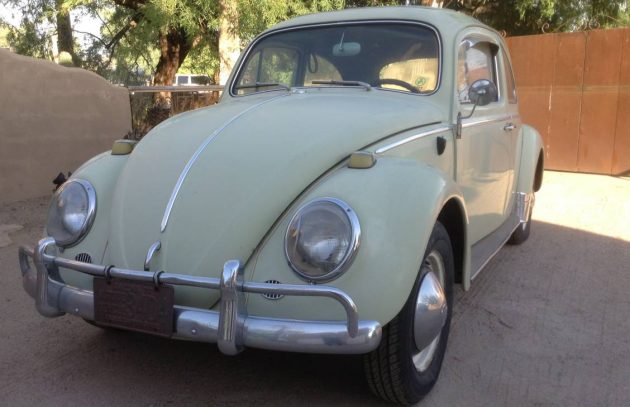
I struggled mightily with whether to share this super clean example of a sunroof-equipped VW Beetle, largely because the seller is coy about the price. But perhaps it was an innocent mistake, and there’s a potentially great project candidate with this dry, cheerful ’64 Bug. You can find this life-long Arizona resident here on craigslist, where the seller promises this one will bring back memories of driving a Beetle in its purest form.
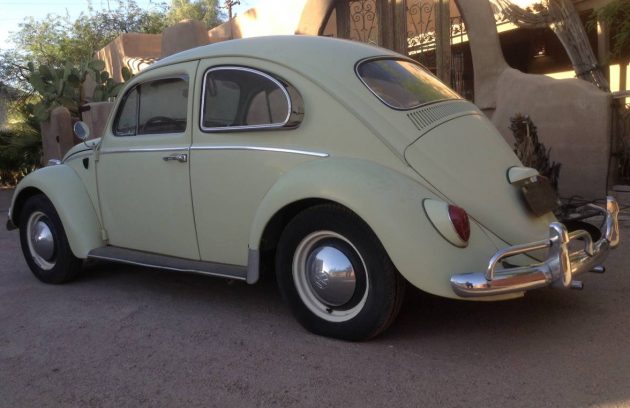
The issues with the unlisted price aside, the seller doesn’t seem to be forgetting any details as it relates to the Beetle’s clean condition. The body looks straight, as do the bumpers and hubcaps. The pop-out windows are one of my favorite features of any car, and they look great on this early-bodied Bug. The seller does mention there is some slight rust, but “no severe cancer.” There’s a big spread between those two conditions and it demands more info from the seller.

The interior is tidy, but I’m unsure of that color combo is correct. Perhaps our Bug experts can weigh in, as the color of the dash would seem to indicate it came from the factory with similar tones on the seating surfaces and door panels, but I could be mistaken. The lack of the original radio is also a bit of a letdown, but overall, the interior looks to have minimal needs if you just want to drive and enjoy.

The seller claims the engine has been rebuilt; no word on if it’s numbers matching. Regardless, the fact that it’s not been hot-rodded or otherwise modified is nice to see, but I can’t help but wonder if that’s the original paint poking through under the engine lid. It’s interesting – from different angles, I can’t even if it’s currently painted blue or white, but the seller calls it brown in the listing. What do you think: is this Bug as honest as the seller says, or are there some stories here?
Source: barnfinds.com
The Volkswagen Amarok Pickup Will Probably Never Make It To The U.S.

Cliuck Here to read all about this truck in the Motortrend Magazine at Motortrend.com motortrend.com .
Karmann Ghia Behind The Shed Find
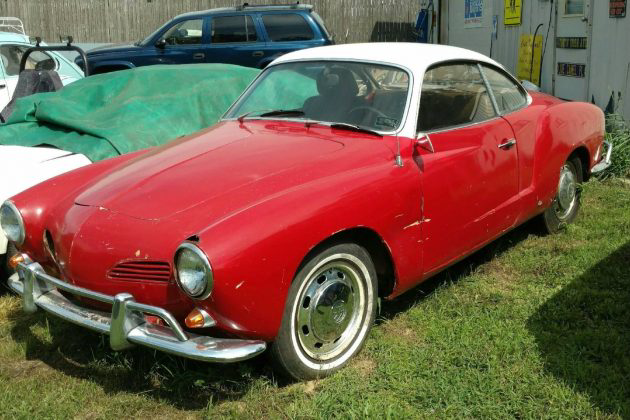
Karmann Ghias are always controversial when we feature them on Barn Finds. To some, they offer an attractive body with the simplicity of Beetle mechanical components; sort of a poor man’s Porsche 356. Others can’t get past the plebian origins of the Beetle and just don’t see the styling as aggressive enough for their tastes. Take a good look at this behind the shed find and let us know what side you fall on in the comments! It’s located in Elkhart, Indiana and is offered for sale here on eBay, with an opening bid of just 99 cents. Of course, there’s a higher reserve than that!
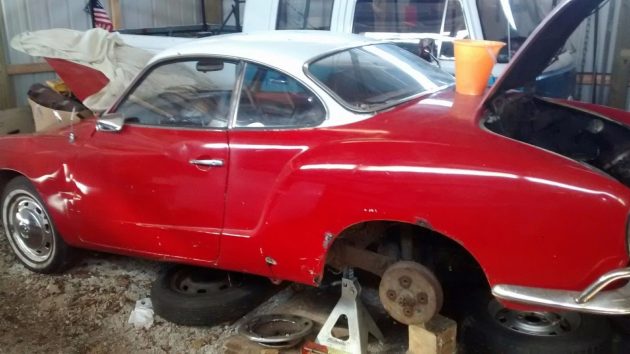
The seller shows the car in several states; we’re not sure which is current, but we do know the engine is currently out of the car and disassembled for rebuilding. One interesting point is that the seller is pretty sure the car is a 1968, but the title says 1970. I’ve run into something similar before with a Triumph Italia that spent two years on a dealer’s lot before selling and it was titled as the year it was sold, so this may be a similar case. It might be worth checking on, though. You can see both dents and rust from this shot, but the little Ghia is still basically solid.
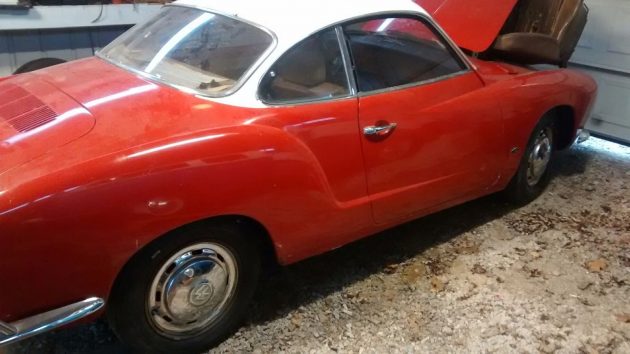
It looks a little better on this side. Does anyone know if they came two-tone originally? I hadn’t seen one and wasn’t able to confirm the fact by searching the internet.
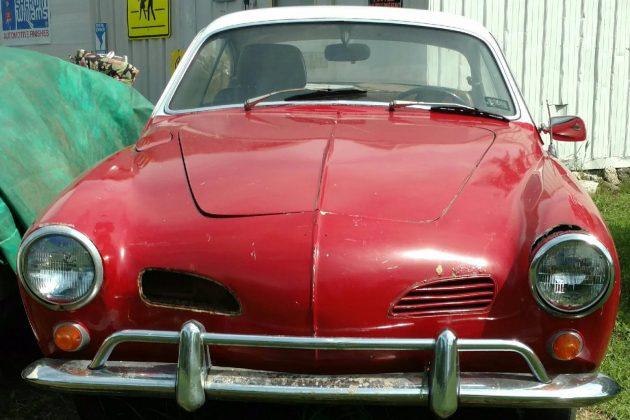
I’m guessing the nose has been hit in the past, based on the mangled driver’s side grille, missing passenger side grille and ill-fitting hood, as well as the totally different shine on the two headlight trim rings. However, this shot is here more to show the hole above the driver’s side headlight. I wouldn’t want to leave that one for too long.
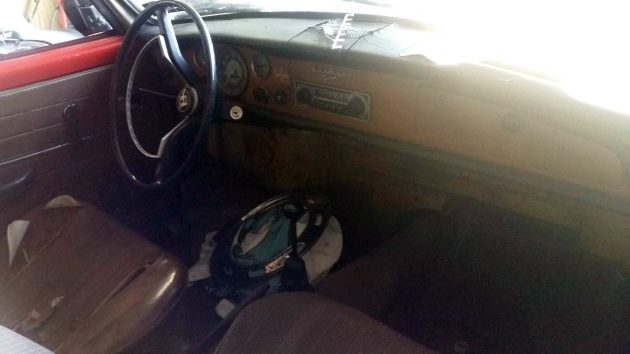
Apart from the usual split seats and dash, the interior doesn’t look bad, and the seller assures us that the pan is in good condition. The semi-automatic transmission is unfortunate, though, as I haven’t heard much good about it (although I’ve never driven one). Any Barn Finds readers with experience that can share with us in the comments?
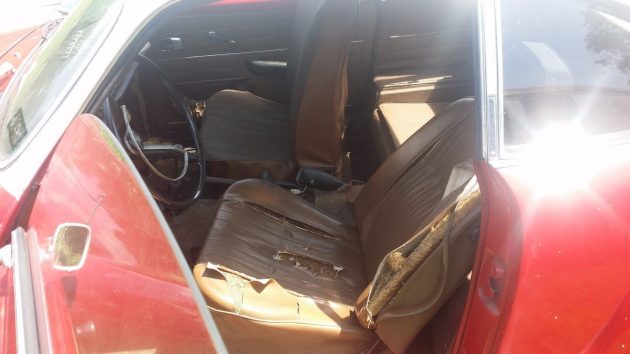
The great thing is that reproduction parts are plentiful and inexpensive for Ghias. Since it’s doubtful that the engine is original, I would probably take the next step and install a manual transmission, unless you folks can convince me otherwise. So is this the Ghia for you? And who can tell me more about the semi automatic?
Source: barnfinds.com
Oval Window Ragtop: 1957 VW Beetle
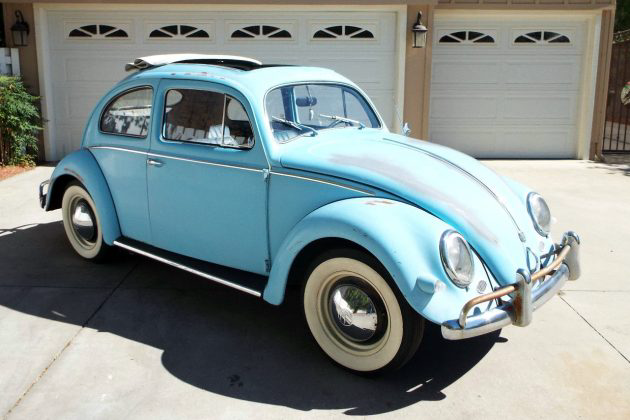
For a car that was designed and built to be affordable basic transportation, it’s amazing how beloved the Beetle is. While the vast majority are still affordable, the earlier examples can fetch big bucks. This one isn’t the most desirable split window design, but the oval window is still in demand. It’s a nice little car that’s showing a nice patina and a sweet ragtop. The seller admits it had one respray years ago and that the interior was redone, but claims everything else is original and in great shape. It sure looks nice and would be fun to have! You can take a closer look at it here on eBay in Simi Valley, California with a high bid of $12k and no reserve. So how do you feel about the patina on this one?
Source: barnfinds.com
Not A Bus Or A Van, But A Pickup!
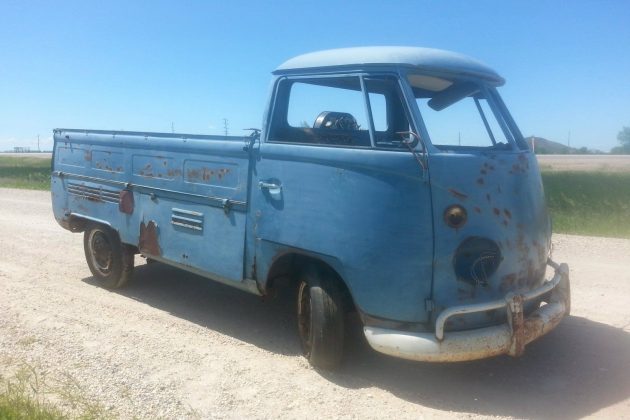
One of the more practical variants of the classic VW Bus platform is this pickup. This late T1 version needs a lot, but there are some solid bones here. It’s located in Corona, California and is being offered for sale here on eBay, with bidding starting at only $1,000 and there’s not a reserve!
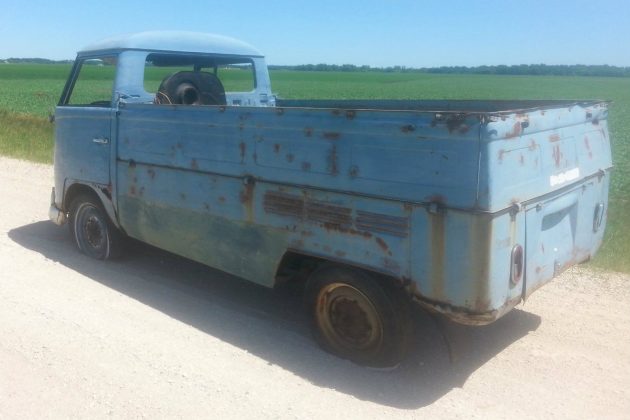
I remember seeing one of these up close once, and I was amazed how both the sides and back folded down for loading. Yes, the load floor is pretty high as a result of the engine location, but look at how high the bottom of the bed is on most modern pickups!
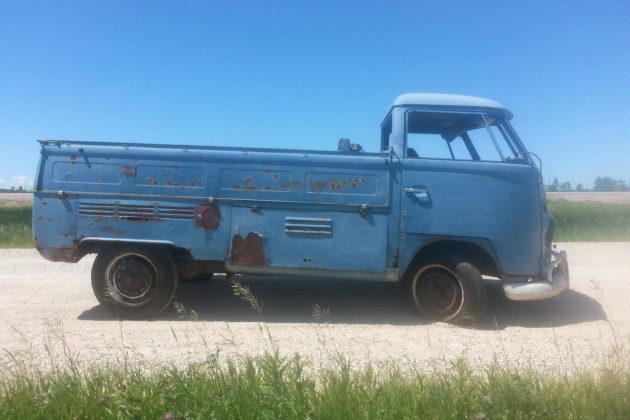
The seller tells us that this was in a field for many years, and that there is some rust on the cab floor and underside as well as the front wheel wells. The ad also states that the rocker panels are rusty and that someone has screwed some sheet metal over them at some point. You can also see that there’s a dent in the front panel by the passenger side headlamp.

Here you can not only see the corrosion in the bed, you can see the “free” engine that’s included in the auction. It’s an 1968 engine that “ran well and is not seized.” Can one of our VW enthusiasts tell if this engine will work to power the truck?

Here’s what the corrosion looks like from the underside. I think you may have enough metal here to
keep, but after blasting or dipping I’m not sure. Then again, you may choose to keep it just as it is.
 image: http://barnfinds.com/wp-content/uploads/2016/07/a6-3-630x420.jpg
image: http://barnfinds.com/wp-content/uploads/2016/07/a6-3-630x420.jpgOn the inside, we see original seats that need to be completely rebuilt, zero glass in place (and none is included) and no interior panels to speak of. While I know some of you like to leave cosmetics as is, I’m thinking everyone would want to do something with the seats. There are a bunch of seat upholstery kit suppliers out there for VW’s, I liked this one in particular though. What would you do with this project in waiting?
Source: barnfinds.com
Thinbugs
Share
Sometimes things just stick in the back of your brain like little morsels of meat after a good porkchop dinner. You could floss it out, but it’s also occasionally rewarding to work at that morsel for a while after the meal. Same goes for those random bits of maybe-true-maybe-fictitious nuggets of car lore you overheard once at a car show or in a buddy’s shop. You could bother researching it to get down to the truth of the matter, or you could ruminate on the idea for a while, facts be damned.
I have one I’ve held on to for a couple decades now. I couldn’t have been more than 14 or 15 when, at some random car show, I came across a narrowed tandem-seat Volkswagen Beetle, sort of like the apparently semi-famous California-based one in the photo above (though not the same one – the one I saw was blue, I think, and either in Ohio or Kentucky). The owner told me that Volkswagen itself built a limited run of narrowed Beetles called Thinbugs, and hell, I didn’t know any better, so I believed him.
Of course, I never saw another one after that, and the longer I went without seeing another one, the more I suspected the owner of that Thinbug was yanking my chain. But even once the Internet came along and I had the ability to research what that guy said, I never looked it up until today – in part because I’d held on to that little bit of apocrypha for so long that I wanted to believe in it regardless of whether it was true. Also, in part, because I didn’t want to accept that I’d been fool enough to believe the Thinbug story.
So let’s all go in for a big flossing today. Tell us about the auto-related stories you’ve bought into but which you suspect might not be true. Or only half-true. Or which you know are complete fabrications but you still hold on to for some reason. Somebody here’s sure to set you straight.
And would somebody clear up the Thinbug story for me once and for all?
Source: blog.hemmings.com
What if Volkswagen built the first Mini? VW’s EA-48 prototype?
Share
[Editor’s Note: Ronan Glon of Ran When Parked visited the AutoMuseum Volkswagen in Wolfsburg, Germany, where he came across this oddly familiar prototype. Here’s the story of the stillborn VW EA-48 city car prototype.]
The original Mini is often credited for laying the foundations of the city car as we know it today. However, that honor almost went to Volkswagen a couple of years before Sir Alec Issigonis’ brilliant creation hit the road.

Volkswagen began experimenting with the idea of a small city car positioned a notch below the Beetle in 1953. At the time, Beetle sales were low at best and showing few signs of improvement, so engineers wanted to introduce a smaller and more affordable model in order to help the company finally get off the ground. On paper, the car was ambitious. It was the first small car from Volkswagen, and the first prototype designed in-house without any input from Porsche. Led by Gustav Mayer, project EA-48 officially kicked off in October of 1953.

Mayer decided that simply shrinking the Beetle wasn’t enough; in fact, he took a completely different approach to designing a car. The EA-48 featured unibody construction, a front-mounted engine, front-wheel drive, and a McPherson-type front suspension. Using both a McPherson front suspension and front-wheel drive was revolutionary at the time.

The EA-48 in Wolfsburg’s AutoMuseum Volkswagen. Remaining photos by Ronan Glon.
Power was provided by a two-cylinder air-cooled engine which was, at its core, essentially a Beetle engine cut in half. Mayer initially designed two different flat-twins for the car, according to Volkswagen Classic magazine. The first was a 700cc unit with a crank-mounted cooling fan, and the second was a 600cc unit with a belt-driven fan. Mayer also considered developing a diesel, but the idea was quickly dismissed by Volkswagen boss Heinz Nordhoff.

Volkswagen decided that the 600cc engine was sufficient, so the bigger twin never made it beyond the prototype stage. Fed by a Solex carburetor, the smaller two-cylinder generated 18 horsepower at 3,800 rpm and 29 pound-feet of torque at 2,500 rpm, enough to send the 1,267-pound car to a top speed of nearly 60 mph. Power was transferred to the front wheels via a four-speed manual transmission.

The car – which was tentatively set to wear the 600 nameplate – needed to be affordable, easy to maintain, and spacious. Unibody construction and 13-inch wheels allowed designers to make formidable use of space, so the EA-48 was nearly as roomy inside as a Beetle in spite of its significantly smaller footprint. And while the production model was set to gain a pair of rear windows, Volkswagen never intended on launching the car with a trunk lid in order to keep costs in check. Mayer explained that, at best, the feature could have been added to the lineup as an extra-cost option later in the car’s production run.

The first EA-48 prototype stretched 133 inches long, 58 inches wide, and 54 inches tall. To put those dimensions into perspective, it was slightly longer in length, wider, and shorter in height than the Fiat 600, which debuted in 1955 and would have been one of the EA-48’s most direct rivals.

Volkswagen began testing its entry-level model on public roads in 1954. It was surprisingly sharp to drive; period internal documents went as far as labeling its handling “sporty.” Mayer was justifiably pleased, but the engine wasn’t as praiseworthy. Not only did the twin run rough, it frequently overheated because the fan was too small. Engineers tried installing a bigger fan from a Lloyd but saw very few improvements, so as a last resort they installed an even bigger fan borrowed from the Porsche parts bin. Porsche ended up playing a small part in the EA-48’s development after all.

Mayer firmly believed that Volkswagen needed to expand its lineup with a small car, but the EA-48 was never approved for production even though its development had reached an advanced stage. One issue was that Nordhoff feared the car would lure customers away from the Beetle, which was starting to get attract buyers in Germany and abroad after a rough first few years on the market. Young Volkswagen had invested so much into the Beetle that Nordhoff was unwilling to risk cannibalizing it.

Interestingly, the final nail in the EA-48’s coffin came from Ludwig Erhard, Germany’s minister of economy. He warned Nordhoff that thousands of jobs would be lost if Volkswagen moved forward with the small car project. The threat allegedly came from Carl F.W. Borgward, an industrialist whose namesake company owned Lloyd, an automaker that tussled for a slice of Germany’s small car segment. The EA-48 project consequently ground to halt in February of 1956. One of the prototypes was scrapped, while the second is on display in the Volkswagen museum in Wolfsburg, Germany.

It’s too bad, because the Volkswagen 600 would have undoubtedly left an indelible mark on the history of the automobile. Walk down a street in just about any European city and take a look around: a majority of the cars that make up the automotive landscape are front-wheel drive, diesel-powered, and fitted with a McPherson-type front suspension. If built the way Mayer envisioned it, the 600 could have been 60 years ahead of its time.
Source: blog.hemmings.com
Subscribe to:
Posts (Atom)
